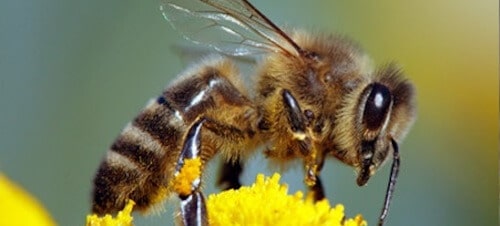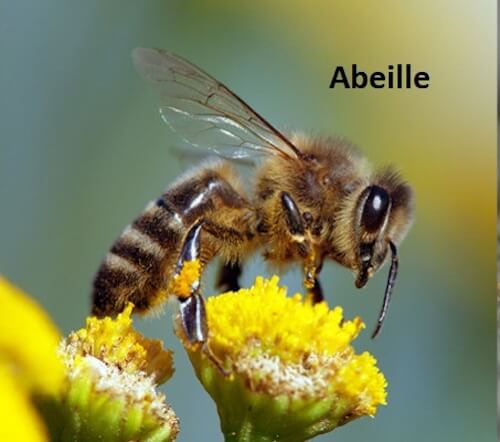Home » Exterminations » Insects » bee
Capture, relocation and extermination of bees
Are you looking for a bee exterminator to perform an intervention following a beehive invasion in your home? Nova Extermination’s specialist technicians can help you deal with the invasion of bees (and their hives) that are causing you a problem. If a beehive or nest is in one of your trees or if it is hanging from your house, shed or garage, our experienced team can safely remove it. We can, if necessary, call on a beekeeper.
Our trained and certified exterminators have many years of experience in the treatment and extermination of a wild honeycomb problem on the South Shore. We have mastered the techniques to deal with this situation and have the necessary equipment to solve your bee problem quickly and sustainably.
It is sometimes difficult to distinguish between bees and wasps, we offer wasp vs bees articles for you to recognize them. In either case, stay away from it!
Only the female bee is equipped with a stinger to attack. Unfortunately for her, it is fatal for them because she dies after stinging.
How to remove a bee’s nest
The government is strict about this: it is forbidden to exterminate bees. Only bee capture is allowed, since these insects are pollinators which are very important for the environment. Indeed, nearly 75% of plants depend on pollinating insects for their reproduction. These insects thus contribute to an important part of the production of most fruits and vegetables.

In our province, fruit crops are the most dependent on pollinating insects such as bees, mainly apples, strawberries, cranberries and blueberries. Nova Extermination follows government guidelines and performs bee (and honeycomb) capture and relocation to the forest, rather than bee extermination.
HOW TO GET RID OF A SWALLOW OF BEES?
Our techniques for exterminating a bee problem are very simple. We’re used to bee catching in all kinds of places. We know their reactions and we know how to approach them smoothly, without getting attacked.
Our exterminators capture bees by trapping them and their hive in a thick bag, then move them safely to a forest. Even if the capture must be done at height, our specialists have the necessary equipment to safely access the place where the hive or honeycomb is located.
Warning: do not attempt to capture a swarm of wild bees on your own. Although generally peaceful, bees can attack and sting if they sense their nest is in danger.
WHO TO CALL FOR A HONEY NEST?
Contact a team of experienced exterminators for the capture of a honeycomb on the South Shore. Our techniques are in accordance with the regulations of the Ministry of the Environment. Unlike other exterminators who only capture bees, we can make sure, if desired, that bees cannot sneak back into your shed, garage or barn to make a beehive. We can carry out an intervention to plug the cracks or holes through which they have managed to penetrate.
It can be difficult for many to tell bees apart from their peers. Understanding their way of life is an art! They are hardworking, formidable and essential to the proper functioning of the environment. However, they can be disturbing when they are in your home.
Knowing more about these will help you differentiate them and see if there is a problem with you.

The bee consumes the nectar and pollen of the flowers, while the wasp feeds mainly on insects and only feeds on a carnivorous diet.
Unlike the bee, which can only sting once, since this results is its death, the wasp has a formidable weapon, it can sting as many times as it wishes.
They also differ from a morphological point of view. The bee has hair and is downy, while the wasp has a smooth body. The bee is about 1.5 cm tall and stocky, while the wasp is longer and has an abdomen separate from the thorax. As for the dress, the bee will be yellow and brown, while the wasp will be black with yellow stripes, the stripes are much more apparent on a wasp than on a bee.
Bees prefer dry, sunny environments that are full of flowers. They can make their nests in several places: a natural shelter, an old mammal burrow, in the ground, in a cavity, in a ledge in a rock, in a tree trunk or any disused place such as a house or shed and a beehive.
Bees have quite a job! To obtain 454 g of honey, bees fly about 80,000 km, which is the equivalent of circling the planet twice!
They have 2 stomachs; the first one is for their digestion, while the second one is for storing the nectar they collect from the flowers. It is also used to transport water which is essential for the manufacture of honey.
Once the nectar is collected, she dries it by dehumidifying it, she carries it to the hive to pass it to the other bees before going back for more!

A South-Shore exterminator must know the rights of the bees to ensure their continuity, but will make sure to solve the problem at your home.
Nova Extermination is a bee exterminator (on the South Shore) that holds all the permits, licenses and liability insurance required to handle wild bees and relocate them. Our techniques comply with the regulations of the Ministry of the Environment.

Nova Extermination’s certified technicians travel to all cities on the South Shore of Montreal for a bee capture. You can contact us by email or by phone at 514-MON-NOVA
For the capture of a bee’s nest on the south shore of montreal

Fill in this questionnaire for a free quote.
We guarantee to get back to you within 12h.

